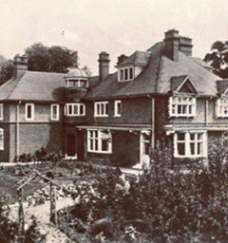Origins
The origins of St Edmund’s College lie in the repeal of the Test Act in 1871, permitting Jewish, Non-Conformist and Roman Catholic scholars to return to the University of Cambridge for the first time since the religious revolution of the sixteenth century. The lifting of this exclusion led to the formation of a small community of Catholic students under the supervision of Fr Edmond Nolan, a former Vice-President of St Edmund’s College at Ware, Hertfordshire. The group of four students settled in Cambridge on 23 April 1896, moving to the former Ayerst Hostel, the site of the present Norfolk Building, on 2 November of that year. Known as St Edmund’s House, the new academic institution was initially a lodging house for students who were matriculated at the different Colleges in the University, and later was recognised as a House of Residence.
St Edmund’s house was co-founded by Henry Fitzalan Howard, the 15th Duke of Norfolk and Baron Anatole von Hügel, Curator of the Museum of Archaeology and Ethnology. Mgr Bernard Ward, the President of St Edmund’s College, Ware, the seminary for the archdiocese of Westminster, supported the initiative by sending three of the first four students, all of whom were studying for the priesthood. Within a few years most St Edmund’s House students had already been ordained to the priesthood before coming into residence as members of the University. They read a range of degrees to equip them for posts in grammar schools and universities.
There was a steady increase in the number of students towards the outbreak of the First World War. During this period the Chapel, which is now a Grade II listed building, was built. Designed by Father Benedict Williamson, CSSP, it was blessed by Cardinal Francis Bourne, Archbishop of Westminster, in 1916. The dining hall and further student rooms were built in 1939 by the seventh Master, John Petit, later bishop of Menevia (1947–72).
Several distinguished scholars have been resident at St Edmund’s House, including Norman St John-Stevas, later Lord St John of Fawsley and Master of Emmanuel College 1991–96. St Edmund’s House was also a home for many distinguished visitors, notably Father Georges Lemaître, widely acknowledged as the father of the Big Bang theory of the origin of the Universe, who was resident here between 1923 and 1924 when he undertook some of his key research.

